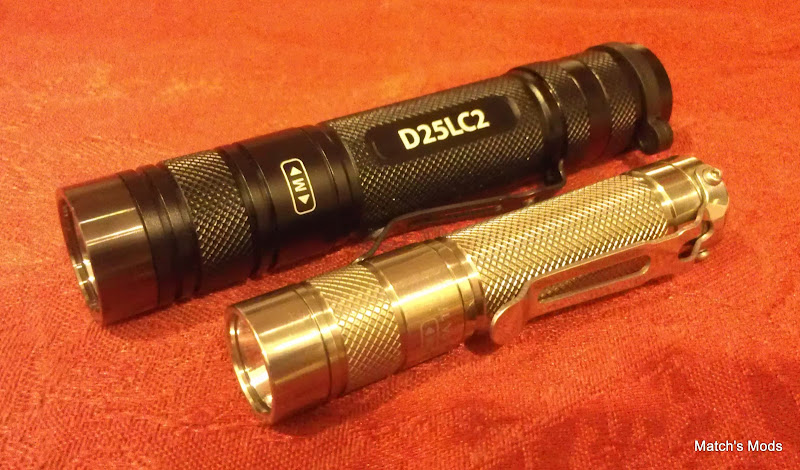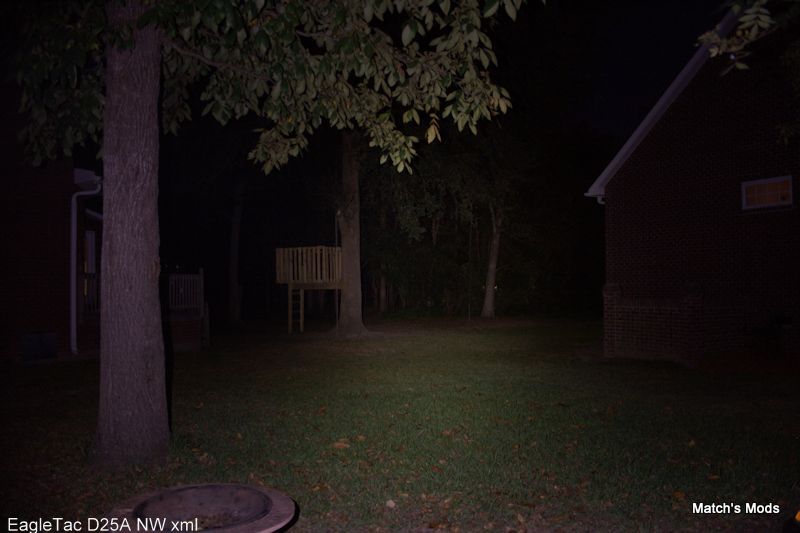EagleTac D25LC2 Clicky XP-G2 Custom
Reviewer's Overall Rating: ★★★★★

Summary:
| Battery: | 1x18650,2xcr123, 2x16430 |
| Switch: | Reverse Clicky |
| Modes: | 5 Brightness / 7 Auxiliary |
| LED Type: | Cree XP-G2 |
| Lens: | AR coated glass lens |
| Tailstands: | Yes |
| Price Payed: | |
| From: | Direct from Eagletac.com |
| Date Ordered: | Sept 2012 |
Pros:
- Exceptionally compact/lightweight 18650 light
- Offers similar performance of xml lights twice its size
- Outstanding build quality and overall fit and finish
- Great Customer service / warranty offered by EagleTac
- Well spaced modes and intuitive U.I.
- Working voltage range from 2.7vdc - 8.4vdc
- Nice reverse clicky switch that allows for tailstanding
- Reasonably priced
Cons:
- No true moon mode.
- No NW tint (was not an option at the time of ordering)
Introduction
It's very rare for me to do product reviews, mainly because the lights I report on have usually been modded to the point where they have little in common with their production based brethren. Even more rare for me is when I get a custom light that I didn't build. That's right folks, the custom D25LC2 here for review is as it was delivered from EagleTac. No emitter reflows, driver swaps, or lathe work on my part...just drop in a fresh battery and go. I must admit, it's refreshing.
So, what sets this light apart from the run of the mill stock? Only one, albeit major difference...and that is the driver. This is a D25LC2 clicky with an XP-G2 emitter AND a C2000RC circuit driver (which is the driver they use for the xm-l). The standard driver as issued with the xpg's from eagletac is the C1500RC (1.5A vs 2.0A). This is a winning combination, as I'll show below. Before I forget, for a more in-depth look at the stock Eagletac please see Kreisler's Opus here. (Thanks Kresil for saving me a lot of typing  )
)


D25LC2 clicky with it's little brother, the D25A Ti clicky
Features/Value: ★★★★★
A good summery can be found on EagleTac's own website here. In use there are two main modes: Head tightened and head loosened. With the head tight, the modes are Max and strobe - Works perfect for me. With the head only slightly loosened, one has access to 3 lower brightness modes (L/M/H). If these are cycled through twice, the 7 auxiliary modes are accessed (blinky modes). I find this arrangement perfect, because they won't activate accidently yet they are still there if needed. The L/M/H output of the head loosened mode can further be lowered by cycling the head from loose to tight 3 times starting from the loose position and the light on. Here's the output of the various modes (sans blinkies):
| Mode | OTF lumens group 1 | OTF lumens group 2 |
| Low | 21.9L | 8.2L |
| Med | 108.3L | 64.6 |
| High | 375L | 374L |
| Turbo | 517L | 517L |
I find the above mode spacing in Group 2 (almost) ideal. I would like to see a lower low mode of ~ .5 - 1L. I'm being nitpicky, but personally that's the only fault I can find with this light.
Design/Build Quality: ★★★★★
My light came with a well centered emitter, lubed and square cut threads, and nice fitting o-rings. Not that I make a habit of such things, but it did survive the impromptu fall into a full bathtub due to a moment of "butterfingers". There was nary a hint of water penetration to be found.
The plastic lanyard split ring at first frightened and confused me.... (caveman grunt here). After realizing that in the event of getting the light snagged on, oh say, a moving piece of machinery...it would be much better for the split ring to give way than ones wrist. The clip can be removed via the retaining ring on the end and...ready for this? If one chooses, it can be easily replaced with a deep pocket carry clip! I consider that a big win for those who don't like the tailcaps sticking out (like me).


The 4sevens deep pocket clip, while just slightly tighter than the original, snapped easily into place and fit like a glove.
As noted above, primary mode groups are switched via tightening and loosening the head. Due to excellent thread fit, this process requires only ~ 1/16th of a twist to activate.
Size wise, it is one of the smallest 18650 clickys out there. It also compares favorably to single and double AA lights. All things considered, this is the best size/output/runtime combination I've come across. Here's a few photos to illustrate that:

Above from left to right: Quark AA2 turbo, Solarforce L2P, EagleTac D25LC2, Trustfire R5-A3, Quark AA X, and EagleTac D25A Ti. Same order below (without the quark turbo):

Light Output: ★★★★★
Looking at the above pictures, notice how much smaller the D25LC2 is than the L2P. Here's the neat thing....after spending considerable time the last two nights playing around outside, I had a very hard time finding much difference in use between the two - which equates to better runtime from a much smaller package along with a superior U.I. How is this possible? My guess is because the XP-G2's throw and spot size (when driven at 2 amps) are able to match the much larger reflector of the P60/XML. The lumen difference spread out in the spill, which for me, is harder to notice. To better illustrate this, I'll post up some beamshots in a moment. First, here's a quick table summarizing output and throw of various lights that I own (except for the stock D25LC2 xml - those numbers are from eagletac's website):
| Light | OTF lumens | Throw |
| Eagletac D25LC2 xpg2 custom | 517L | 11,500cd |
| Zebra SC60 | 300L | 3,000cd |
| Shiningbeam S-mini (xpg2) | 327L | 6,650cd |
| MF UF 3mode XML drop-in | 838L | 11,400cd |
| EagleTac D25LC2 XML | 548L | 5,200cd |
| NaitHawk M.1 rotory xpg | 186L | 6,520cd |
| Quark AA2 Turbo xpg | 241L | 8,250cd |
| Quark AA2 X xml | 341L | 2,970cd |
| CNQG 1x18650 host xml | 726L | 6,120cd |
So, comparing the the Eagletac to the ubiquitous Manafont UF XML P-60 drop-in, on paper it looks to be only slightly behind on thow but ~350L shy on overall output. As I mentioned earlier though, in practical use I did not notice the missing lumens. What I did notice however was the increase in runtime and less overall heat generation, not to mention the the compactness of the torch. Even comparing this custom Eagletac to it's stock brother D25LC2 XML, it only gives up 60L for double increase in lux! I'll take that trade any day.
And now for the beamsots  . In the following pics, the distance to the tree house is 36yds and the trees beyond it are at 40yds. Cannon EOS Rebel XTi,ISO 400, aperature 3.5, exposure 2"
. In the following pics, the distance to the tree house is 36yds and the trees beyond it are at 40yds. Cannon EOS Rebel XTi,ISO 400, aperature 3.5, exposure 2"
I'll post various lights (labeled in the pictures) with a mouse over. In every case, the mouseover will be the custom EagleTac D25LC2 XP-G2:







Summary: ★★★★★
So there you have it. If you're looking for a very small cylindrical 18650 light with a great U.I. AND has a bit of throw, the custom EagleTac D25LC2 XP-G2 is the ticket.
Would you like one yourself? Think it won't happen because you don't have some magic ET connection? Nope. Getting one was the easiest process in the world. In fact, this all started when I contacted ET directly to inquire on obtaining a C2000RC driver to mod my own regular D25LC2 xpg2. The delightful service rep Christina offered to have one made at the factory that way directly - so how was I to refuse? To sneak it into the production took ~ 2 weeks, and shipping was an expedient 2 days from China (new record for me).
So, if you'd like one of your own just contact Eagletac Customer Support and ask Christina you'd like a modded D25LC2 like Match's. Send a little money, sit back and relax, and enjoy the anticipation of receiving the best little 18650 I've had the chance to play with yet. Heck, they may have access to the NW binned xpg2 by now...
Thanks for reading, and if you have any other questions please ask!
-Match

